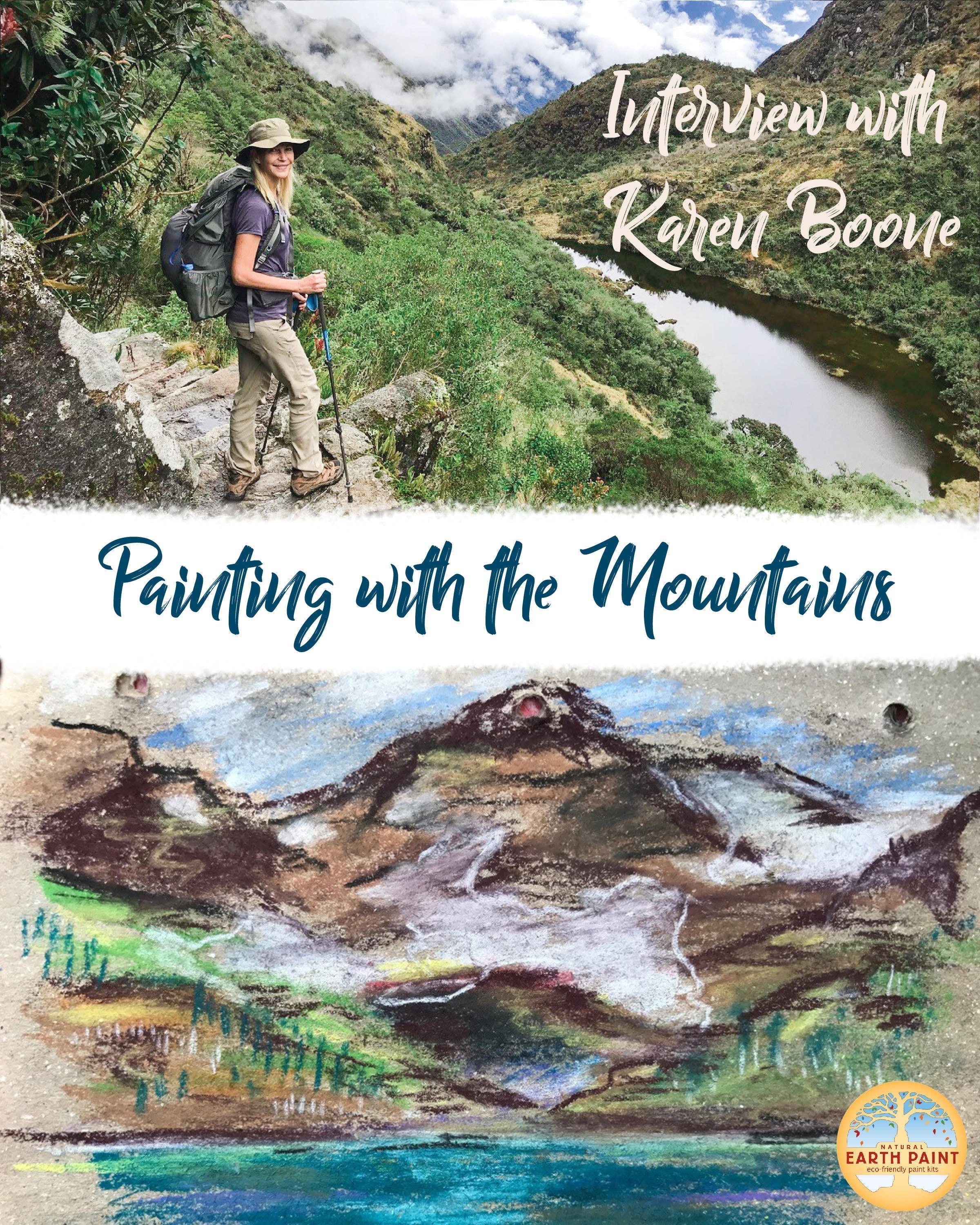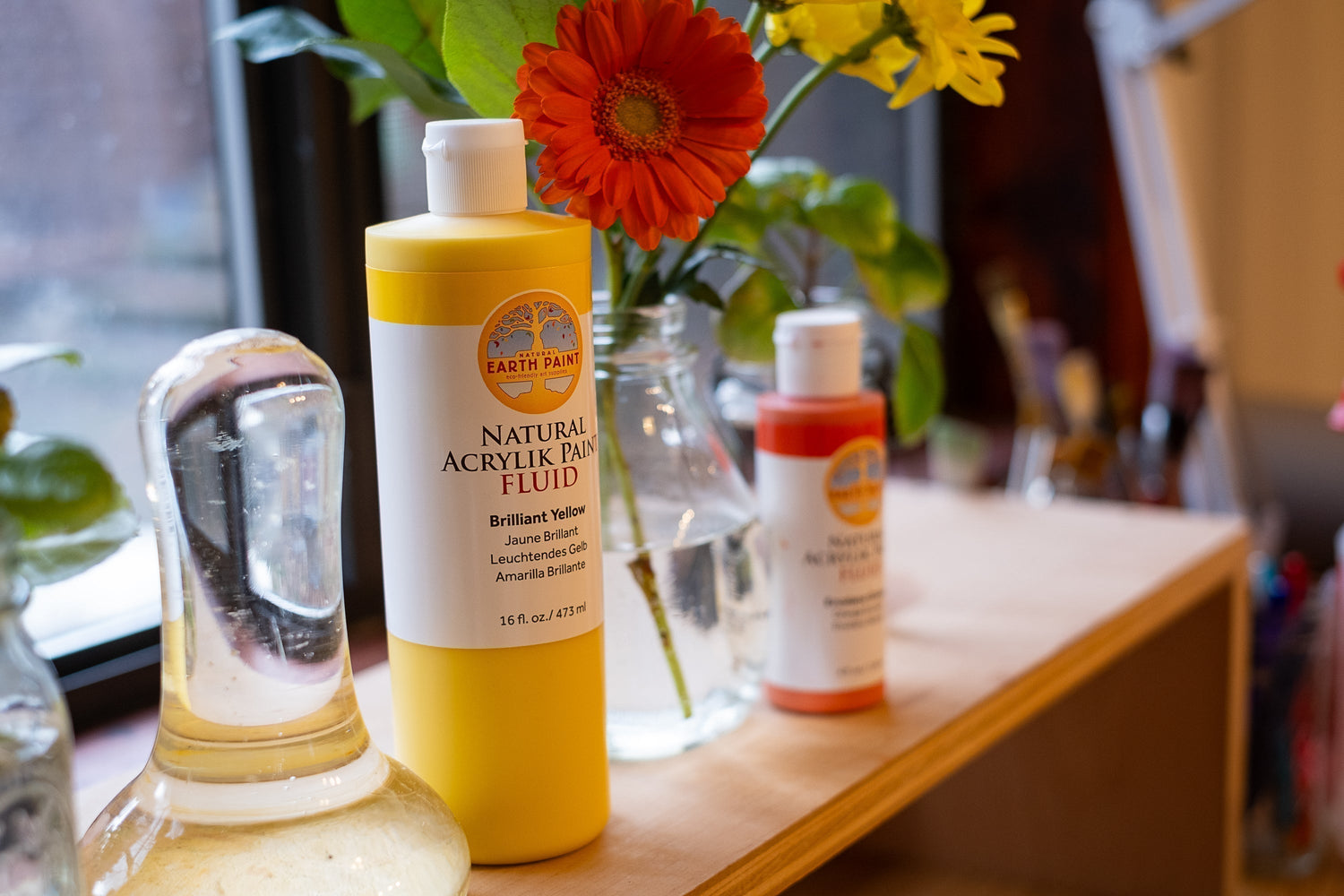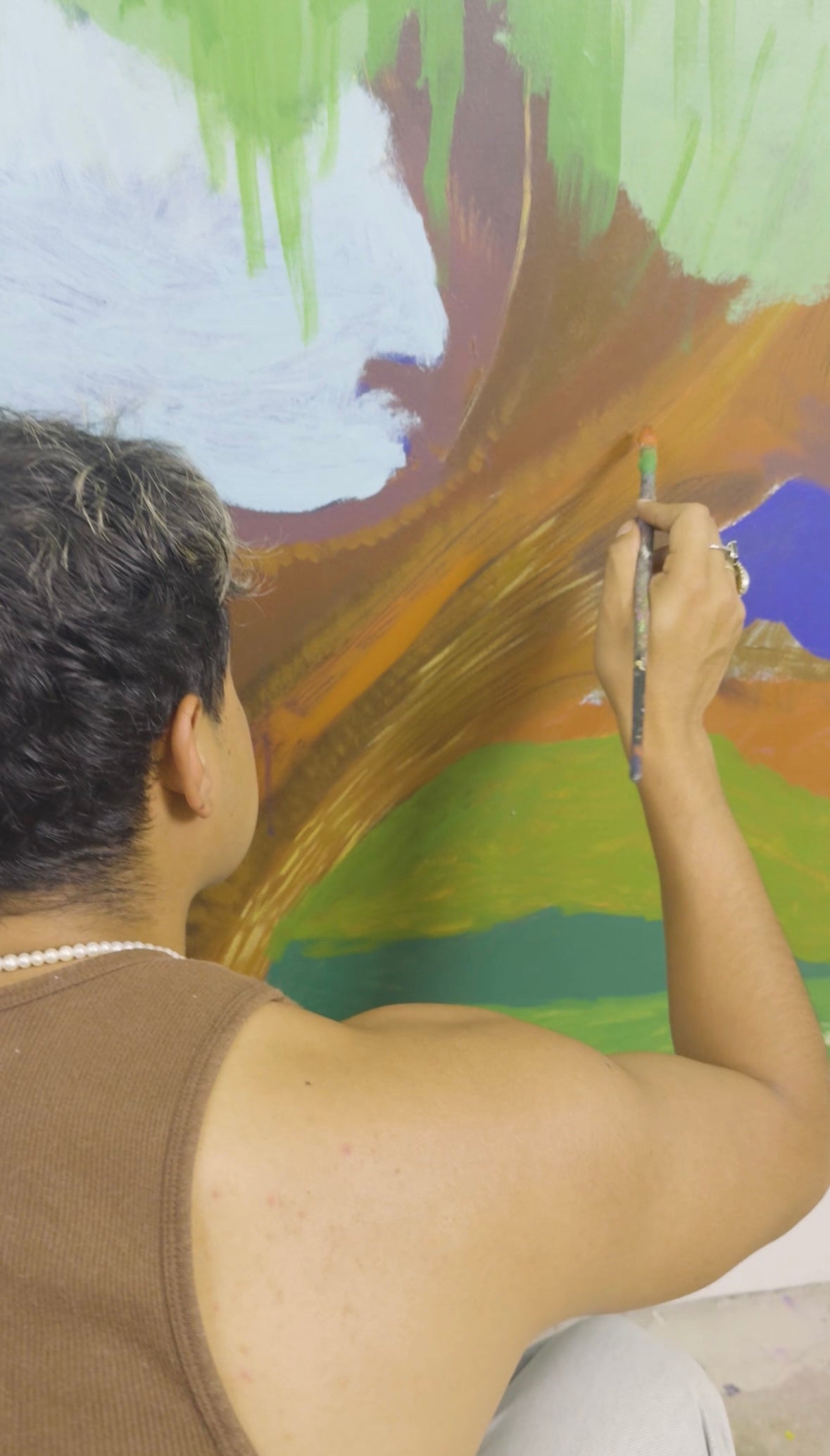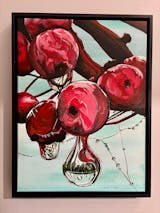Thank you so much, Karen, for taking the time to share your experiences with us! Can you start by telling us a little bit about your personal history - where you grew up and how did that place or landscape affect your life as an artist?
I grew up in Louisville, Kentucky, which has beautiful, green, rolling hills and the Ohio River. It propelled me on a lifelong journey of appreciating nature. After living all over the world as a graphic designer, I have settled on 10 acres in Borden, Indiana with my husband Rick Runyon, where I am building a small art studio that overlooks our lake and forest.

What art training did you receive?
I attended the University of Louisville (’82) where I focused on Graphic Design. I then received my advanced degree at the Basel School of Design in Switzerland. We were taught composition, color, and simplicity in design. This is also where I found my love of hiking. I am a self-taught painter, I have never taken a painting class.
Were you ever taught about art supplies safety - How to protect yourself from toxic supplies and which supplies were toxic?
It was never mentioned.
What types of paint and supplies did/do you primarily use and what were/are your safety precautions (if any)?
Like many artists I used store-bought acrylics, oils, gesso, toxic thinners and cleaners. About 10 years ago, I decided that I wanted my supplies to reflect my life, I had been vegetarian for many years, a hiker, a recycler, a minimalist in my buying choices. So I decided to try some amish milk pigment that I bought online. I liked it, and then I found Natural Earth Paint. I use your pigment, organic cotton canvas, eco gesso, and eco-solve. I also find my own clays and charred wood to crush and mix with walnut oil for pigment. I use a simple mask when mixing up batches of gesso or pigment to avoid inhaling dust, but I feel very comfortable with my supplies now.

Did you ever have any adverse health issues from using these supplies?
Headaches from the harsh chemical smells. But I feel that if I had continued a lifetime of painting supplies that contained so many toxins it would not be healthy. Also I don't like painting with plastic, which is essentially what acrylic paint is.
Did you have concerns about safe disposal of toxic supplies?
I don't use anything toxic at this time, but when I did use cleaners I felt bad about pouring them down the drain, which ultimately goes into our water supply.
How were you first introduced to making your own paints from natural earth and minerals?
This was something that I just started to explore on my own. I am an avid hiker and backpacker, so I am naturally drawn to the beauty of rocks and clay. I never take anything from National or State Parks (Leave No Trace). I find little bits of clay in creek beds and along roadsides which is far less toxic or demanding on the earth’s resources than if I buy synthetic store-bought paint. A handful of clay or charred wood makes a lot of pigment, and I have clay on my property.

How do you incorporate Natural Earth Paint products into your practice?
I use your ultramarine purple, french turquoise, ultramarine blue and white pigment, which are harder for me to source in nature, especially to be lightfast. I like your natural impasto to thicken pigment. I stretch my own canvas using your organic cotton canvas and your plant-based gesso (no horse hooves or rabbitskin).
How does the act of harvesting your materials in nature and making your own supplies affect your painting process?
It slows me down, the harvesting, drying, crushing, and mixing all takes time, like a meditation. It gives me time to think about what I want to paint, and I don't waste as much, especially colors that are harder to find.

What’s your favorite thing about finding and collecting paint supplies in nature?
I subliminally remember the environment more deeply, the rich tones of brown, grey and red, the textures. I think the spirit of the land actually flows into the painting when I use natural pigments. My paintings are often described as soothing or calming, even when I am painting mountains or waterfalls that have a lot of energy.
Do you have any tips for artists who also want to de-toxify their studio? Were there any challenges? What made the process easier? What have the benefits been?
Just start reading online, and experiment. I would have little pieces of canvas or paper taped to walls testing to see if certain pigments were lightfast. Not having the off-gassing from paintings resonates with buyers. The process is not easier, but I feel it is my responsibility to work as cleanly as possible, a less toxic earth is a big benefit. I also use a palette knife, or the edges of a small rock or a stick to make marks into the paint. Paintbrushes are often not humanely produced, if I use them I try to use faux hair brushes.

Do you have any tips for artists who also want to harvest their own pigments?
Ask if you may take a little clay or pigment from someplace, don’t assume you can take it. Be mindful of sacred grounds and nature preserves. I also have had friends bring me clays from their property once they know I am interested. So ask around.
Which artists throughout time inspire you the most?
Georgia O’Keefe (deceased), Rebecca Crowell (living artist)

What is the main inspiration for your work?
Nature, particularly mountains and water. I like to backcountry backpack, so I take small watercolor pencils and paper to sketch while in the field, then larger paintings when I return to the studio.
How do you find balance and stay connected to the natural world in the typically disconnected, busy-ness of todays world?
I hike, my husband and I run most mornings at a nearby state park, we usually do at least two larger backpacking trips per year, like the 250 mile John Muir Trail, the Grand Canyon, Glacier National Park, Utah, the Canadian Rockies. And we have a long list of places we would still like to hike. I also do yoga which helps with equanimity and balance.

How would you describe your artistic style?
My sketches done on trail are fairly realistic but precious to me, because sometimes we are in survival mode when hiking 20 miles a day over mountain passes in all types of weather. My bigger pieces created in the studio are abstract. I try not to copy a particular photo, but let the colors and shapes of different natural places blend together in my mind, to create a new landscape, with just enough structure and perspective to give it a sense of place.
We at Natural Earth Paint are hoping to inspire a "Slow Art Movement" and encourage artists to slow down their process and take the time to hone their craft, create their own art materials like the Old Masters, and develop a real connection with their process - allowing the inspiration to come at it's own time and taking the time needed to create it. This reminds me of your work, does this resonate with you at all?
Absolutely. The preparation of canvases and crushing and mixing pigment takes time and research. I don't feel the need to rush the process. I also like to work at a reasonable size, not every piece has to be over-sized. As artists we are responsible not just for the chemicals we use but should be mindful of creating waste. I will always create art and people love to buy art, all civilizations have proven that. But making timeless art, something that will last both in the material sense and the image is very important to me.

Tell us about any upcoming shows or how can we see more of your art?
I would love to be represented by an environmentally friendly gallery anywhere in the world, or in group shows with other sustainably-minded artists. I currently have paintings on my website at www.karenboone.com

Karen Boone
502.488.0566
https://www.facebook.com/karen.boone.35
https://www.instagram.com/karenboonedesign/?hl=en
Creating sustainable art inspired by backpacking adventures
Interested in learning more about Natural Earth Paint artists? Visit our Eco Artists page!
Follow us on Instagram, Facebook, and Pinterest for more natural inspiration.







